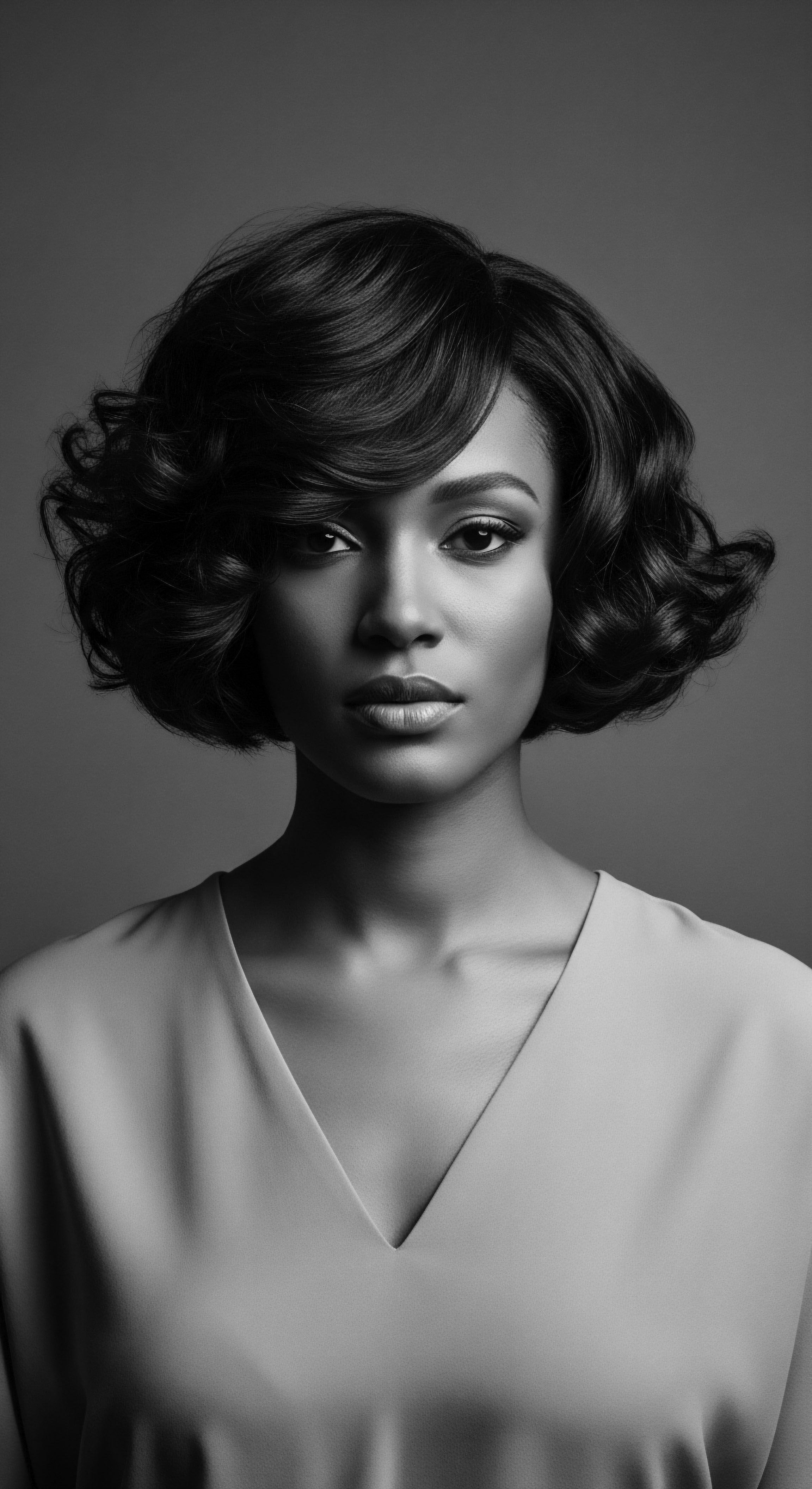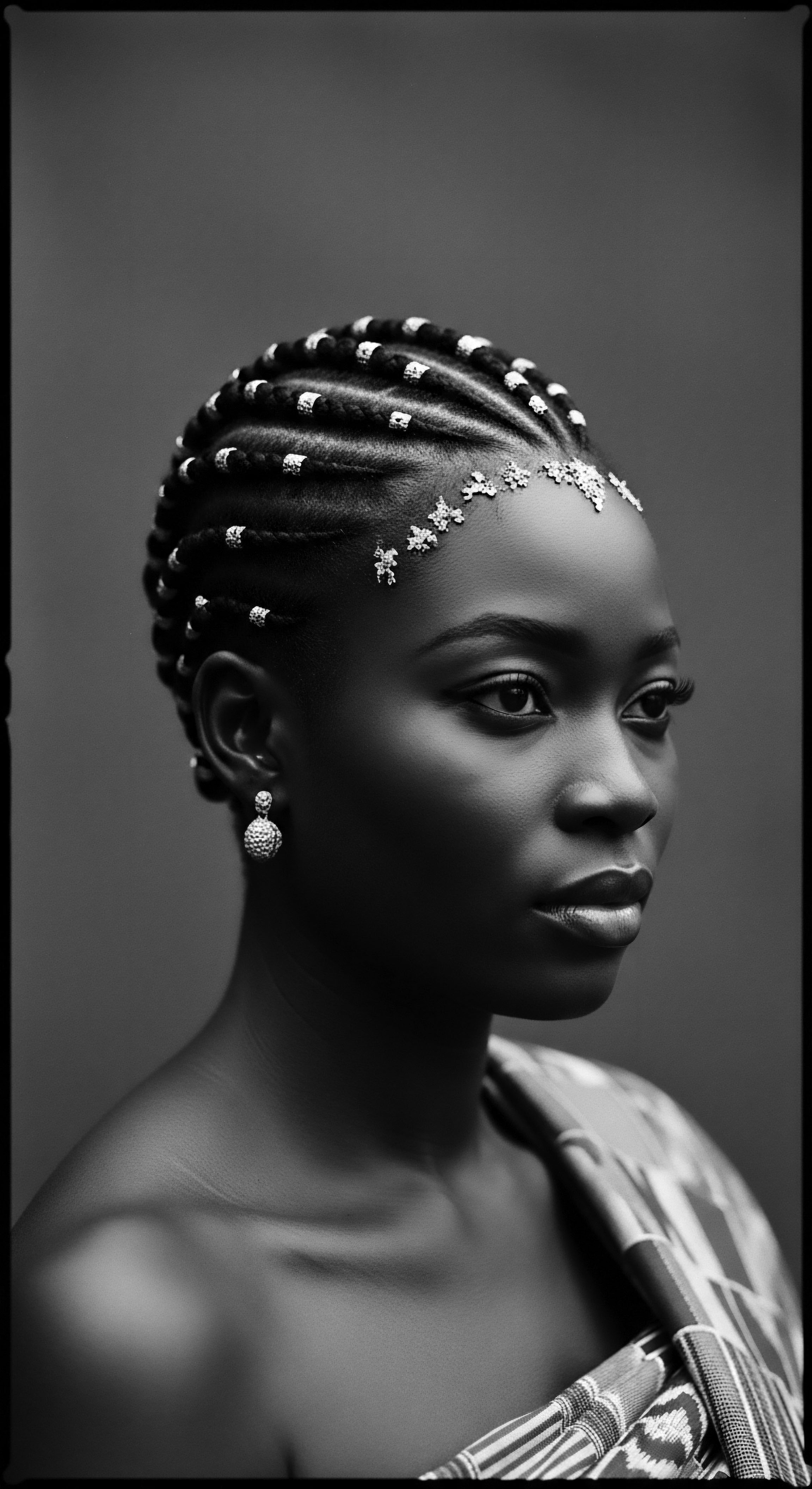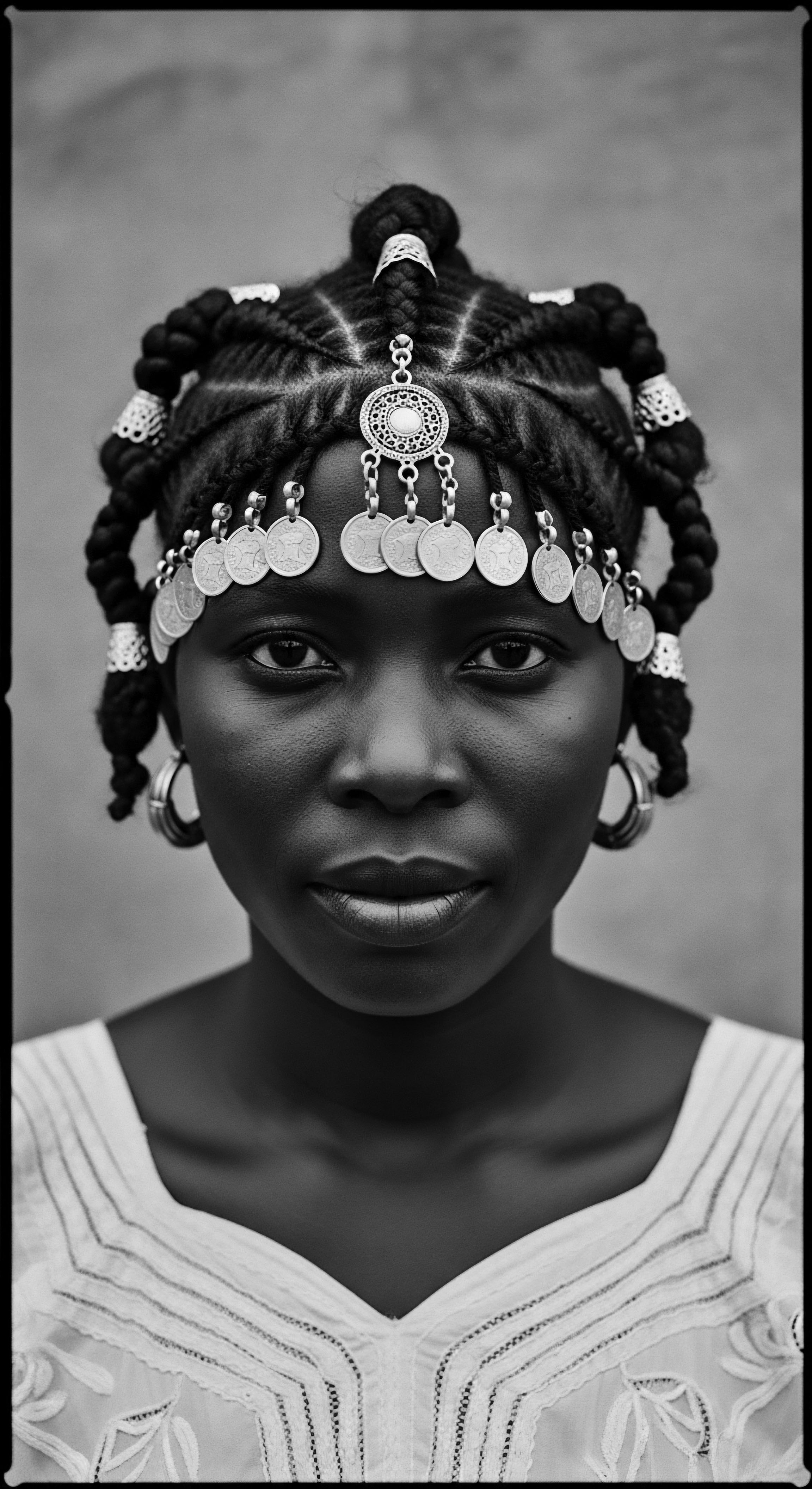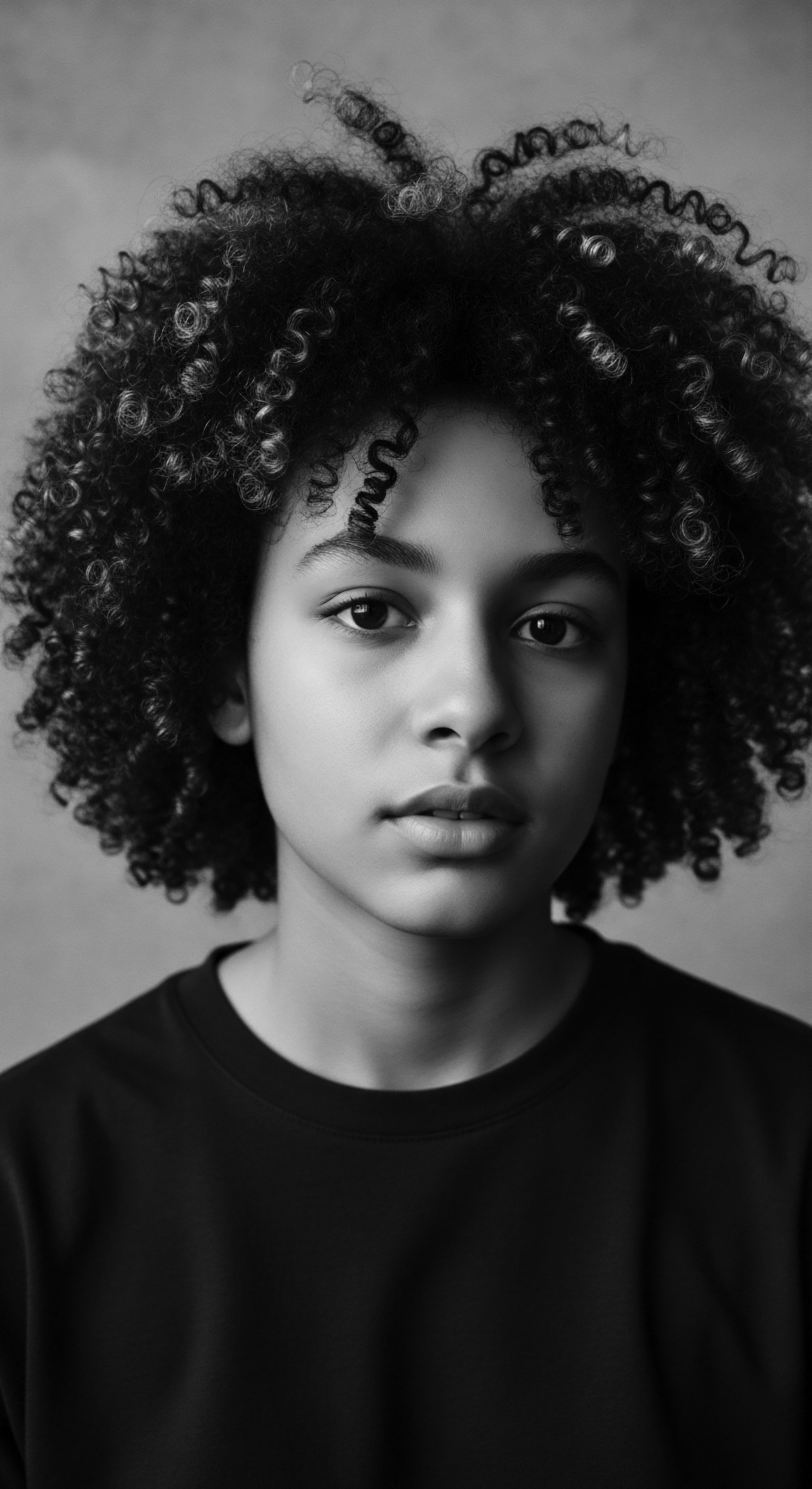
Roots
Consider the quiet hum of a strand, unfurling its coiled journey from scalp to tip. It is a story, a deep memory held within each filament, whispering tales of sun-drenched savannas, bustling market squares, and hushed nocturnal rituals. For those whose lineage traces through the intricate spirals of textured hair, this story feels particularly resonant, a living chronicle passed down through the very act of care.
Long before brushes of boar bristle or synthetic teeth found their way into our hands, there were combs. These were not mere instruments for detangling or arranging; they served as extensions of the hand, of the heart, of the community itself, often speaking volumes without uttering a sound.
The earliest of these tools, perhaps a sharpened bone shard or a sliver of polished wood, were born from necessity, a practical answer to the unique needs of coiled and kinky textures. Yet, even in their most rudimentary forms, these combs carried the indelible mark of human intention. They were fashioned, not simply found.
This fundamental act of crafting, of shaping a raw material to serve an intimate purpose, established an immediate connection between the maker, the user, and the object. Over countless generations, this connection deepened, intertwining with the very fabric of communal life, creating a heritage where the simple comb transcended its utility.

The First Touch An Ancestral Whisper

Early Toolmaking and Textured Strands?
From the earliest archaeological records, combs appear as companions to humanity, tools adapted to specific environments and hair types. For millennia, various cultures crafted implements to groom hair, and for those with highly textured strands, the design imperatives differed considerably from those for straighter forms. A robust construction, wider spacing between teeth, and a smooth finish became paramount to navigate the natural coils and prevent breakage. These early combs, often modest in their presentation, still bore the fingerprints of their creators, hinting at an evolving relationship between humanity and its hair.
The selection of materials was never arbitrary. Stone, bone, horn, and wood were chosen for their durability, their availability, and sometimes, for their perceived spiritual properties.
The initial purpose of a comb was certainly practical ❉ to maintain hygiene, to remove debris, and to prepare the hair for styling or ceremonial adornment. Yet, even this foundational care held a deeper cultural significance. The act of grooming, whether solitary or communal, became a ritual of connection to self and to others. It was in these quiet moments of tending that the comb began to accrue symbolic weight, an unassuming tool slowly transforming into a canvas for identity.

Carvings as Primal Markings?

Echoes of the Artisan’s Hand
As communities developed more sophisticated forms of artistic expression, the comb became a miniature tableau, a surface upon which stories, beliefs, and statuses could be etched. The initial markings might have been rudimentary, perhaps to improve grip or to identify the maker. Gradually, these marks evolved into deliberate designs, each line and curve imbued with intention.
These were not random embellishments; they were deliberate statements, a visual language spoken through wood, ivory, or metal. The very act of carving demanded skill and patience, investing the object with the artisan’s energy and knowledge.
For instance, in certain ancient West African traditions, the creation of combs was often a specialized craft, passed down through generations. The skill of the carver was itself a respected position within the community. The careful smoothing of the wood, the rhythmic chipping, and the delicate incising of patterns were all part of a sacred process.
These artisans often held a deep understanding of local cosmology and social structures, translating these complex ideas into tangible forms. The finished comb, therefore, did not merely exist; it spoke, it taught, it reminded.
Ancient comb carvings served as silent storytellers, reflecting a community’s values, beliefs, and societal structures.
Materials chosen for early combs held specific associations.
- Wood often represented connection to the earth, to nature’s cycles, and to the strength of trees.
- Bone might have carried spiritual significance, linking the user to ancestral spirits or animal power.
- Ivory, especially in regions where it was accessible, signified wealth, prestige, and often, connection to royalty or powerful lineage.
| Material Wood |
| Common Use/Cultural Association Ubiquitous, practical, often imbued with local spiritual significance. |
| Material Bone/Horn |
| Common Use/Cultural Association Durability, symbolic ties to animals, ancestral connections. |
| Material Ivory |
| Common Use/Cultural Association Prestige, wealth, often associated with royalty or elite status. |
| Material The selection of raw materials for comb creation was deeply intertwined with available resources and societal values. |

Ritual
From the fundamental embrace of a tool designed for textured hair, ancient comb carvings began their steady ascent into the realm of the ceremonial, the ritualistic, and the profoundly personal. This elevation was not accidental; it grew from the intimate connection between hair, identity, and the daily rhythms of life. Hair care, particularly for textured strands that demand patience and specific techniques, was never a solitary act in many ancestral communities.
It was a time for bonding, for teaching, for sharing oral histories. Within these communal moments, the comb, initially a simple aid, acquired layers of meaning, becoming a visible testament to one’s place within the collective.
The patterns, figures, and symbols carved into these combs transitioned from mere decoration to meaningful inscriptions. These visual codes communicated everything from marital status to age, from religious beliefs to aspirations for fertility or protection. Each line etched, each form rendered, contributed to a silent dialogue between the wearer, the comb, and the community observing it. It was a tangible form of self-expression, a way to convey one’s personal narrative while simultaneously reinforcing communal norms and values.

Comb Carvings as Social Markers

How Did Specific Designs Convey Social Information?
The symbols found on ancient combs were not universally understood, of course. Their meanings were deeply rooted in specific cultural contexts, often requiring an intimate knowledge of local traditions and belief systems to fully decipher. A particular geometric pattern might signify membership in a certain clan, while an animal effigy could represent a protective spirit or a family totem.
The placement of these designs, their size, and even the type of wood or ivory used, all contributed to the comb’s communicative power. These were not accessories; they were declarations.
Consider the Akan Combs of Ghana and Côte d’Ivoire. These tools, often crafted from wood, frequently incorporated Adinkra Symbols. Adinkra, a collection of ideograms and pictograms, each carrying a specific proverb or concept, turned the comb into a portable philosophical statement. A comb bearing the Sankofa symbol (a bird looking backward with its head turned forward) might be presented to a young woman, reminding her to learn from the past while moving into the future.
Such a gift was not simply functional; it was didactic, a gentle lesson embedded in a daily object. These combs were often passed down through generations, becoming Heirloom Pieces that carried the collective wisdom and moral compass of the family.
Intricate carvings on combs served as visual dialects, articulating an individual’s role, wisdom, or aspirations within their cultural sphere.

Hair Care Ceremonies and Comb Presentation?
In many African societies, the grooming of hair, particularly for young people transitioning into adulthood, was a significant ceremonial event. During these rites of passage, new combs might be presented, often carved with symbols relevant to the individual’s new status or responsibilities. This act of presentation reinforced community expectations and celebrated the individual’s growth.
The comb became a tangible link to a deeper tradition, a physical representation of the individual’s acceptance into a new phase of life. The meticulous nature of maintaining textured hair meant these combs were used frequently, ensuring the message they carried was regularly seen and internalized.
The care given to the comb itself often mirrored the care given to the hair and, by extension, to the self and community. A highly decorated comb, perhaps worn prominently in an elaborate coiffure, indicated not only the wearer’s status but also the respect they held for tradition and for the artistry of their community. The comb became a repository of communal heritage, its carvings a testament to shared narratives and values.
The tradition of communal hair care, where combs were shared or used in tandem, fostered a sense of togetherness and collective responsibility. These grooming sessions, often women-centric, served as informal schools where younger generations learned not only styling techniques but also the deeper cultural meanings associated with their hair and its adornments. The carvings on the combs acted as silent prompts, sparking conversations about lineage, virtue, and belonging.
| Carving Type/Symbol Geometric Patterns |
| Potential Communal Significance Clan affiliation, spiritual unity, order, or lineage. |
| Carving Type/Symbol Animal Effigies |
| Potential Communal Significance Totemic power, protective spirits, specific virtues (e.g. strength, wisdom). |
| Carving Type/Symbol Human Figures/Faces |
| Potential Communal Significance Ancestral veneration, depictions of deities, beauty ideals, or social roles. |
| Carving Type/Symbol Abstract Forms |
| Potential Communal Significance Proverbs, philosophical concepts, or abstract representation of natural elements. |
| Carving Type/Symbol The visual vocabulary of comb carvings provided a rich tapestry for expressing complex social and spiritual concepts. |

Relay
The journey of the carved comb, from a simple grooming tool to a profound statement of community standing, mirrors the enduring strength and adaptability of textured hair heritage itself. These artifacts are not static relics of a distant past; they are vibrant testaments to the human need for expression, connection, and belonging. Examining these ancient combs reveals not just artistic skill, but a sophisticated understanding of social hierarchy, spiritual belief systems, and the intrinsic value placed upon personal adornment within collective identity. For cultures where textured hair was the norm, the comb was an indispensable part of daily life, and its embellishment elevated it to the status of a living document.
In analyzing the complexities of comb carvings, we move beyond mere observation to a deeper comprehension of how these seemingly small objects functioned as powerful agents of social communication. The intricacy of the carving, the preciousness of the material, and the specific iconography employed could all signal one’s position within a social stratum, one’s marital status, or even one’s spiritual alignment. This layering of meaning speaks to a sophisticated cultural intelligence, where every element of personal presentation contributed to a broader narrative understood by all within the community.

Crafting Status and Identity

What Did Materials and Carving Skill Reveal About an Individual’s Community Standing?
The material of a comb often spoke volumes before a single carving was discerned. Consider, for instance, the contrast between a simple, utilitarian wooden comb and one crafted from rare, lustrous ivory. In communities where elephants roamed, ivory was a material reserved for the elite, for royalty, or for those of significant spiritual authority. The procurement of ivory itself often required resources and influence, making the finished comb a symbol of wealth and power.
Beyond the material, the level of skill invested in the carving further underscored status. A comb adorned with finely detailed, complex patterns, executed with precision, indicated access to highly skilled artisans, who were themselves esteemed members of society. Such a comb was not mass-produced; it was a bespoke creation, a marker of individuality within a collective identity.
The Luba People of Central Africa, for example, produced combs that were not only functional but also potent symbols of authority and historical memory. Their combs often depicted stylized female figures or intricate geometric patterns, which could signify connections to royal lineages or ancestral spirits. These combs were sometimes carried by chiefs or diviners, acting as miniature mnemonic devices, assisting in the recitation of genealogies or historical narratives during ceremonial gatherings (Roberts & Roberts, 1996, p. 74).
The comb, therefore, transformed from a personal accessory into a communal archive, its carved forms preserving the very essence of Luba heritage and leadership. The artistry involved was a reflection of the reverence held for both the objects and the societal structures they represented.
The choice of materials and the intricacy of ancient comb carvings served as clear indicators of social standing and access to skilled craftsmanship.
Beyond the overt symbols, the very condition and preservation of a comb could also convey information about its owner’s dedication to tradition and personal presentation. A well-maintained, cherished comb suggested a person who valued their heritage and invested care into their appearance, which often aligned with societal expectations of respectability and diligence.

The Enduring Voice of Ancestral Aesthetics

How Do These Ancient Objects Continue to Speak to Textured Hair Heritage Today?
The aesthetic principles embedded in ancient comb carvings resonate deeply with contemporary discussions surrounding textured hair heritage. The celebration of form, the emphasis on natural materials, and the intentionality behind each design echo modern movements that champion indigenous beauty standards and holistic care practices. These historical objects serve as tangible evidence that the intricate care and adornment of textured hair are not recent phenomena but are rooted in a rich, millennia-old legacy of self-expression and cultural pride.
For many of Black and mixed-race descent, these ancient combs offer a powerful connection to ancestral practices that predate colonial influences and the imposition of Eurocentric beauty ideals. They remind us that the beauty of textured hair was not only recognized but celebrated and elevated through art and craftsmanship. Studying these combs contributes to a broader understanding of identity, resilience, and the continuous thread of heritage that binds past to present. It provides validation and a sense of rootedness in a history that often remains underrepresented in mainstream narratives.
The act of choosing a comb today, particularly one crafted with natural materials and thoughtful design, can be seen as a quiet continuation of this ancestral dialogue. It is a conscious decision to align with practices that honor the unique characteristics of textured hair and the profound heritage woven within each coil. These ancient comb carvings, therefore, are not just museum pieces; they are living testaments, guiding us toward a deeper appreciation of the beauty and significance inherent in our textured strands. They beckon us to remember, to reclaim, and to celebrate the enduring legacy of our hair.
- Historical Validation Ancient combs confirm the long-standing value and intricate care given to textured hair in pre-colonial societies.
- Artistic Inspiration The designs and craftsmanship continue to inspire contemporary artisans and designers, blending traditional motifs with modern aesthetics.
- Cultural Reclamation They serve as tangible links to ancestral practices, aiding in the reclamation of indigenous beauty standards for Black and mixed-race communities.
- Educational Tools These artifacts provide concrete examples for educating new generations about the rich historical context of textured hair care and its communal significance.

Reflection
From the silent whisper of the first crafted tooth to the eloquent declarations etched into ceremonial pieces, ancient comb carvings stand as profound meditations on the intimate connection between identity, artistry, and communal belonging. Their story is deeply intertwined with the heritage of textured hair, a narrative of resilience and expression that echoes through generations. These simple, yet immensely significant, instruments transcend their utilitarian purpose, emerging as living archives of a people’s values, beliefs, and aspirations.
They remind us that the adornment of hair has always been a language, a means by which individuals communicated their place in the world, rooted firmly within the embrace of their collective history. The enduring spirit of these ancestral objects gently guides our present understanding, urging a reverence for the intricate beauty of textured strands and the deep wisdom held within the very act of tending them.

References
- Roberts, Mary Nooter, and Allen F. Roberts. Memory ❉ Luba Art and the Making of History. The Museum for African Art, 1996.
- Drewal, Henry J. and John Pemberton III. Yoruba ❉ Nine Centuries of African Art and Thought. Center for African Art, 1989.
- Adams, Monni. African Dress ❉ A Select and Annotated Bibliography. African Studies Association, 1982.
- Spring, Christopher. African Textiles Today. Smithsonian National Museum of African Art, 2012.
- Thompson, Robert Farris. Flash of the Spirit ❉ African and Afro-American Art and Philosophy. Vintage Books, 1984.
- Sieber, Roy, and Roslyn Adele Walker. African Art in the Cycle of Life. National Museum of African Art, 1987.
